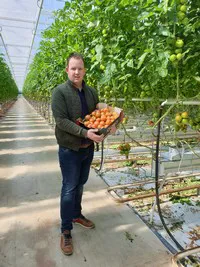Due to all of the attention that is being given to snack tomatoes and vine tomatoes in recent years, you would almost forget that there even is such a thing as loose, round tomatoes. So how are the loose, round tomatoes doing these days? What developments is the segment seeing, and where are all of the fans of loose tomatoes? Who else but the tomato growers are best equipped to provide a satisfying answer to these questions? John van Heijningen and Rob Oosterom: “The segmentation of the tomato market is not disadvantageous to us.”
On the website of Tomato Nursery van Heijningen, it specifically says that the company specializes in the cultivation of ‘traditional loose tomatoes’. A conscious decision, says tomato grower John van Heijningen. “What we cultivate most closely resembles the traditional loose tomato as we know it from the past: a tomato of around 85 grams.”
The way he phrases it shows that this  has not always been the case. “About thirty years ago, the focus of the tomato growers shifted to yield per square meter even more than in the preceding years, and it became increasingly important to just grow more and more tomatoes. During that time the vine tomatoes were on the rise and many growers switched to cultivating those. We did this as well, although we always continued to cultivate loose tomatoes. Those loose tomatoes became larger due to the product focus and were well on their way to weighing 100 grams and sometimes even more. Most of the loose tomatoes that are cultivated these days weigh in at around 100 grams, but at a certain point we decided to go back to the slightly smaller loose tomatoes and even stopped the cultivation of vine tomatoes altogether.”
has not always been the case. “About thirty years ago, the focus of the tomato growers shifted to yield per square meter even more than in the preceding years, and it became increasingly important to just grow more and more tomatoes. During that time the vine tomatoes were on the rise and many growers switched to cultivating those. We did this as well, although we always continued to cultivate loose tomatoes. Those loose tomatoes became larger due to the product focus and were well on their way to weighing 100 grams and sometimes even more. Most of the loose tomatoes that are cultivated these days weigh in at around 100 grams, but at a certain point we decided to go back to the slightly smaller loose tomatoes and even stopped the cultivation of vine tomatoes altogether.”
Investing and sorting
Divided across three locations, John cultivates 7 hectares of these smaller, loose tomatoes and 4 hectares of the larger variety of around 100 gram, together with his brother Johan. The reason for choosing the smaller, loose tomatoes was mainly made from a packaging point of view. “Since 2013, we own a packaging company together with fellow growers Gebroeders Van Nieuwkerk called ToPack. Because of this we started seeing breeding trials in a whole new light, and have decided to go with a tomato variety that in our opinion is most suited to be packaged. This tomato is different from what is perceived as the current norm in the market.”

At nursery Lijntje, where Rob van Oosterom is in charge of the 2.5 hectares that company has, they also choose to cultivate loose tomatoes with a set of unique qualities. “In our greenhouses, we cultivate a loose tomato with a higher Brix value than you would normally find, and seed treatment for an enhanced flavor. This is a combination that is one of a kind in the Netherlands. No one else has it.
As far as I know, my grandpa once started with the cultivation of loose tomatoes and this hasn’t changed ever since. Through the years, vine tomatoes have been added of course and after that, all sorts of different specialties were added as well, but where a lot of growers made a complete switch to a different specialty, we continued growing the loose tomatoes, which was a well thought out decision. We always examined what would be the best fit for our company, and in our opinion the loose tomato is still best.
Organization wise, it does require a bit more work in terms of the loose tomato cultivation in comparison to, let's say, the cultivation of vine tomatoes. For instance, you need to teach people how to pick the loose tomatoes in a specific way. You also need to deal with multiple sorting moments, which means that, as a grower, you will need to make extra investments in a sorting machine.”
For the British sandwich
After sorting, the tomatoes from Nursery Lijntje are transported in boxes of 6 kilograms each to Best of Four, which facilitates the sales. Small packaging is something that the customer can then choose for themselves. At Nursery van Heijningen they already do the packaging beforehand. “We package the small loose tomatoes of 85 grams in a flow pack of six tomatoes each. The larger tomatoes are packaged in nets of 1 kilogram each.”
John sells his tomatoes via Van Nature, after which most of the tomatoes find their way to the UK. “The nets are in high demand in Ireland, while 95 percent of the flow packs are sold in the United Kingdom. In our experience, the quality requirements on the English market are higher than in the rest of Europe, similar to the time when we were cultivating vine tomatoes. You can still really create added value over there.”
Even after the Brexit? “Yes, transportation might become a bit harder, but the Brits are still deciding for themselves what they eat. A delicious tomato slice in their salad or on their sandwich will remain in their diet in my opinion.”
And what about the Netherlands, any tomatoes going there? “No, almost none. The loose tomatoes you find in stores over here are almost all originally from Spain. This mainly has to do with the price. In terms of fruit and vegetables, the Dutch can hardly be called chauvinistic, and the Dutch supermarkets are really aware of the price.”
Rob doesn’t see his tomatoes in the Dutch shops either. His tomatoes are mainly transported to the east of Europe in spring and autumn, while during the summer, France and Italy become the biggest markets. “Besides that, a lot goes to Scandinavia, but not to the big retailers. We are too small to supply them. But this does not take away from the fact that we still sell a lot on a contract base in order to stably sell our base load. The open market is a hard place to sell loose tomatoes. It is a small market with a lot of price fluctuations. The supply is relatively small, but because of that, the tipping point is also reached quicker. It is not uncommon for there to be a shortage which means the price can increase in an instance.”
Without the crown
Vine tomatoes have a stem and loose tomatoes have a crown. At least, this used to be the case. These days many loose, round tomatoes are cultivated without the crown. Rob: “The crown, just like the stems, contributed to the loose tomato’s appearance. However, the crown, which was also viewed as a freshness indicator by the consumers, has pretty much completely disappeared. Slicing the tomato doesn’t happen by hand anymore, but by using a machine. For this reason, it is more convenient for the crown to already be removed so the tomato can easily roll into the cutting machine and come out perfectly sliced. Cultivating without the crow does, however, require more labor on our end, but for this, we are now also breeding. There are even varieties that can be harvested without the crown and leave behind the stem these days.”
Segmentation
The segmentation that has been taking place for the last couple of decades, has turned the cultivation of loose tomatoes into a niche. Out of the 1787 hectares that are used for tomato cultivation in the Netherlands, 932 hectares are used for the cultivation of vine tomatoes. In 2018, loose tomatoes were cultivated on 364 hectares, of which, based on Statistics Netherlands figures, around 270 hectares were used for the cultivation of loose, round tomatoes and the rest for other tomato types like beef tomatoes. In Belgium, the total acreage used for tomato cultivation, 560 hectares, is equally divided between loose and vine tomatoes.
The fact that the acreage used for loose tomatoes has significantly decreased since the rise of vine tomatoes, is mainly due to the growers themselves, according to John. “In the end, they decide what they grow. The fact that the vine tomato is easier to grow is an important factor. For instance, the cultivation of vine tomatoes is easier to automate. So it’s not strange that so many growers have chosen to cultivate vine tomatoes at one time or another. Especially when you don’t see a return on the extra costs that you make as a grower of loose tomatoes in the price you get.”
With the rise of snack tomatoes, just to name one, and all sorts of specialties, the market is now more segmented than ever before. John: “The market has become more diverse, and that is a good thing for the total tomato production. Everyone has started to specialize.”
The at first massively decreased area of loose tomato cultivation has been stable for the past years. No direct growth is to be expected, but rather a slight decrease. “There will be some growers quitting in the coming years”, Rob expects. “It’s mainly older growers with old companies that end up stopping. Not necessarily because the companies don’t cut it anymore, but because the growers are retiring due to their advanced age. In our niche you can easily stand your ground, due to the segmentation there is a market for everyone. However, I don’t see a grower switch from vine to loose tomatoes that easily. Better yet, if I would be able to rent or buy an extra greenhouse I would probably end up choosing to grow vine tomatoes as well, if only due to the fact that there is less labor required for cultivating, which in turn makes it cheaper.”
This article previously appeared in the 4th edition, 33rd volume of the AGF Primeur trade journal. See www.agfprimeur.nl.
For more information:
Nursery Lijntje
Rob Lijntje
rob@kwekerijlijntje.nl
Tomato Nursery Van Heijningen
www.tomatenkwekerijvanheijningen.nl
John Van Heijningen
john@tomatenkwekerijvanheijningen.nl
